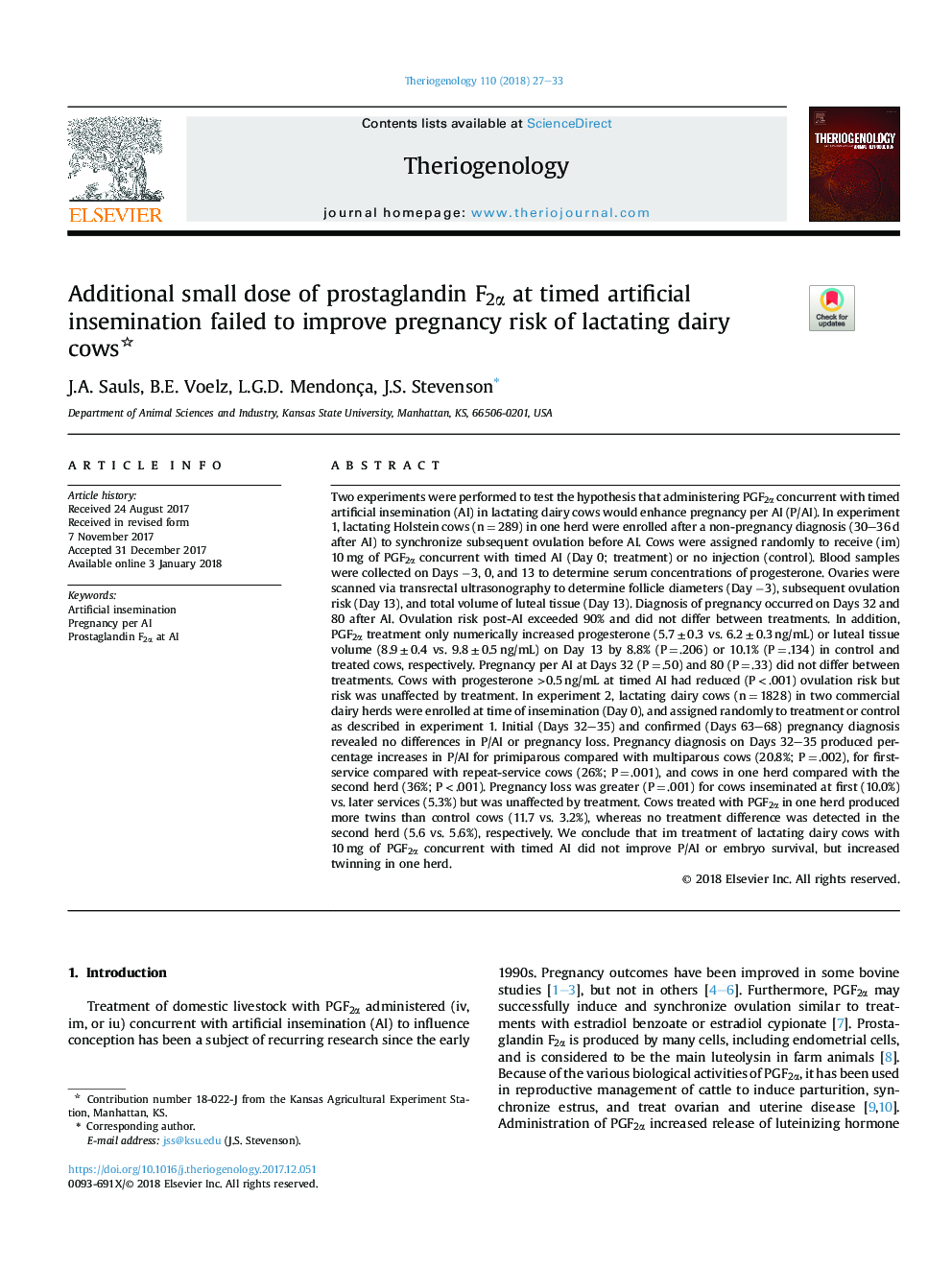| Article ID | Journal | Published Year | Pages | File Type |
|---|---|---|---|---|
| 8427338 | Theriogenology | 2018 | 7 Pages |
Abstract
Two experiments were performed to test the hypothesis that administering PGF2α concurrent with timed artificial insemination (AI) in lactating dairy cows would enhance pregnancy per AI (P/AI). In experiment 1, lactating Holstein cows (nâ¯=â¯289) in one herd were enrolled after a non-pregnancy diagnosis (30-36â¯d after AI) to synchronize subsequent ovulation before AI. Cows were assigned randomly to receive (im) 10â¯mg of PGF2α concurrent with timed AI (Day 0; treatment) or no injection (control). Blood samples were collected on Days â3, 0, and 13 to determine serum concentrations of progesterone. Ovaries were scanned via transrectal ultrasonography to determine follicle diameters (Day â3), subsequent ovulation risk (Day 13), and total volume of luteal tissue (Day 13). Diagnosis of pregnancy occurred on Days 32 and 80 after AI. Ovulation risk post-AI exceeded 90% and did not differ between treatments. In addition, PGF2α treatment only numerically increased progesterone (5.7â¯Â±â¯0.3 vs. 6.2â¯Â±â¯0.3â¯ng/mL) or luteal tissue volume (8.9â¯Â±â¯0.4 vs. 9.8â¯Â±â¯0.5â¯ng/mL) on Day 13 by 8.8% (Pâ¯=â¯.206) or 10.1% (Pâ¯=â¯.134) in control and treated cows, respectively. Pregnancy per AI at Days 32 (Pâ¯=â¯.50) and 80 (Pâ¯=â¯.33) did not differ between treatments. Cows with progesterone >0.5â¯ng/mL at timed AI had reduced (Pâ¯<â¯.001) ovulation risk but risk was unaffected by treatment. In experiment 2, lactating dairy cows (nâ¯=â¯1828) in two commercial dairy herds were enrolled at time of insemination (Day 0), and assigned randomly to treatment or control as described in experiment 1. Initial (Days 32-35) and confirmed (Days 63-68) pregnancy diagnosis revealed no differences in P/AI or pregnancy loss. Pregnancy diagnosis on Days 32-35 produced percentage increases in P/AI for primiparous compared with multiparous cows (20.8%; Pâ¯=â¯.002), for first-service compared with repeat-service cows (26%; Pâ¯=â¯.001), and cows in one herd compared with the second herd (36%; Pâ¯<â¯.001). Pregnancy loss was greater (Pâ¯=â¯.001) for cows inseminated at first (10.0%) vs. later services (5.3%) but was unaffected by treatment. Cows treated with PGF2α in one herd produced more twins than control cows (11.7 vs. 3.2%), whereas no treatment difference was detected in the second herd (5.6 vs. 5.6%), respectively. We conclude that im treatment of lactating dairy cows with 10â¯mg of PGF2α concurrent with timed AI did not improve P/AI or embryo survival, but increased twinning in one herd.
Related Topics
Life Sciences
Agricultural and Biological Sciences
Animal Science and Zoology
Authors
J.A. Sauls, B.E. Voelz, L.G.D. Mendonça, J.S. Stevenson,
